List of Authors
>>About this blog
Recent blog post
|
[Sumida Fireworks]
December 26, 2014 14:00
This year is another few days. In addition, a new year will begin, and I think some people will be entrusted with a new determination for the first sunrise as a start event.
I think the first sunrise from central Tokyo has become a standard from the top of high buildings and towers, but it is not necessarily seen from near the ground.
The Sumida River flows east and south sides of Chuo-ku, and there is a slight distance to the opposite bank, so there are several places where you can see sunrise without buildings on the opposite bank.
This time, referring to past photos, I dared to find a place where I could see the first sunrise from the Sumida River in Chuo-ku. This is an introduction that goes back upstream from the downstream of the Sumida River.
【1】
First of all, "Kachidokibashi".
You can see the direction of Kachidoki on the opposite bank from Tsukiji, but it is a Tokyo-like sunrise with the sun coming out between the building and the building.
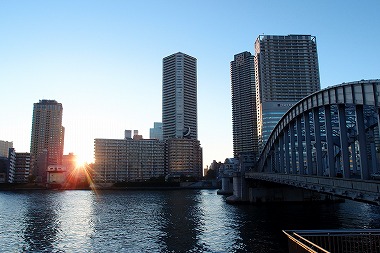
※2014/12/17 Shooting
【2】
Sunrise scenery seen in the direction of Toyosu from "Ishikawajima Park" near "Aioi Bridge".
"Ishikawajima Park" is a good place to see the first sunrise.
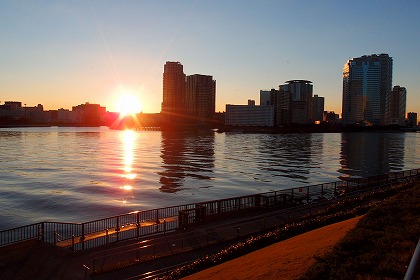
From Aioi Hashigami, the triangles of the truss bridge create a mysterious sight.
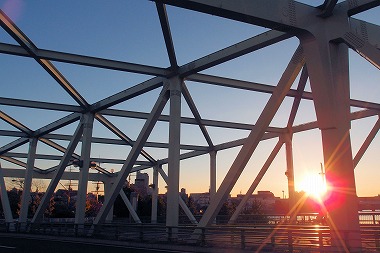
You can also see it from Nakanoshima, which is under Aioi Bridge. Watch the sunrise while fishing ... It's luxurious.
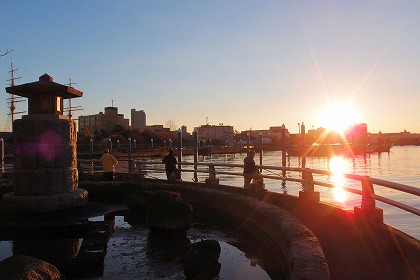 ※2014/12/6 Shooting ※2014/12/6 Shooting
【3】
You can also see the sunrise from the top of the Chuo-ohashi Bridge.
The photo is from last year (New Year's Day 2013), and although it was a little cloudy, it was the first sunrise seen through the "Messenger Statue" watching the Sumida River.
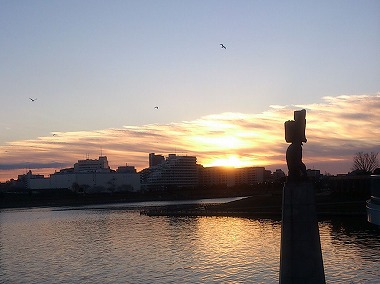
【4】
It can also be seen from "Kiyosu Bridge".
The photo is from this year (New Year's Day 2014) and is a very impressive sight. It is a bridge of important cultural properties, but the first sunrise can be said to be an important cultural property class.
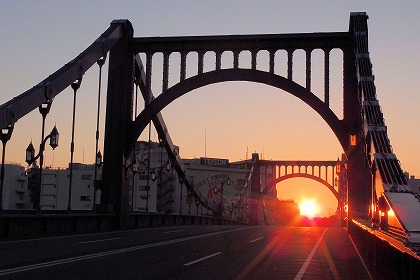 ※Be careful of traffic because you can't see it unless you go on the road for half a step. ※Be careful of traffic because you can't see it unless you go on the road for half a step.
【5】
Finally, "Shinohashi".
You can see it from the top of the bridge, but the photo shows the sunrise from the Sumida River terrace under the bridge.
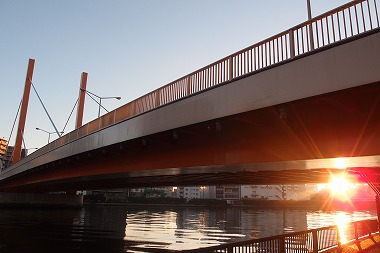 ※2014/12/13 Shooting ※2014/12/13 Shooting
This is an introduction of the first sunrise spot from the Sumida River.
The sunrise time is around 6:50. The problem will be the weather on the day, but I hope it will be clear.
There seems to be some trains running all night. It might be good to go to new year worshipping after the first sunrise.
I hope you will have the best start of the new year.
(Note: Some photos are not from the day of New Year's Day, and some may not be seen due to differences in the position of sunrise.)
<Nearest station>
【1】 Kachidokibashi: Kachidoki Station on the Oedo Line
【2】 Aioi Bridge: Tsukishima Station on the Yurakucho Line and Oedo Line
【3】 Chuo-ohashi Bridge: Tsukishima Station on the Yurakucho Line and Oedo Line
【4】 Kiyosubashi: Suitengumae Station, Kiyosumi Shirakawa Station on the Hanzomon Line / Kiyosumi Shirakawa Station on the Oedo Line
【5】 Shinohashi: Toei Shinjuku Line Hamacho Station / Morishita Station / Oedo Line Morishita Station
[Taro Edo]
December 25, 2014 14:00
You can see winter constellations at Akashi Time Dome.
It's perfect for a date with a full mood.
1st term until Sunday, March 8
2 Place Akashi Time Dome
3 Contents [screening three times a day]
 1st Fuyu no Hoshizora (with subtitles) 1st Fuyu no Hoshizora (with subtitles)
Detective Conan's Starry Sky Magician
Detective Conan, familiar with TV and movies, finally appears in the planetarium.
The confrontation between Kid and Conan unfolding under the starry sky. I'm looking forward to it.
◉From Tuesday to Friday at 3:00 pm
◉11:30 a.m. on Saturdays, Sundays and Holidays
 Explanation of the second starry sky Explanation of the second starry sky
[HAYABUSA BACK TO THE EARTH]
Hayabusa is an asteroid explorer launched in May 2003 and overcame numerous difficulties in 2010. This work is full of realism that adds images of the earth's return scene to the exploration journey filled with the turbulence and excitement of Hayabusa, which explores the mystery of the birth of the solar system.
◉From Tuesday to Friday 4:30 pm
◉2:30 p.m. on Saturdays, Sunday and public holidays
 3rd Winter Starry Sky 3rd Winter Starry Sky
"Night of the Galactic Railway"
We thoroughly consider the fantasy world of Miyazawa Kenji's "Night of the Galactic Railway", which was said to be difficult to visualize, and reproduce it clearly. Experience the dream time as if you were on a real galaxy railway, wrapped in an impressive landscape you have never seen before.
◉Tuesday to Friday 6:00 p.m.
◉Saturday, Sunday and public holidays 4:00 p.m.
4 Appreciation fee
300 yen (preschool children)•Free for elementary and junior high school students in the city)
5 Inquiries
Local Tenmonkan "Akashi Time Dome"
TEL: 03ー3546ー5537

[Shitamachi Tom]
December 22, 2014 13:00
This year will be over soon. The flow of the year is fast. Chuo-ku is a commercial town, so this season is exactly the time of writing, such as shops and department stores. It's full of shoppers to prepare for New Year's Day.
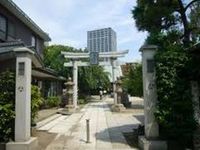 On the other hand, many shrines in the ward have a ritual called "great exorcism" on New Year's Eve. It has been practiced since ancient times as an important event to purify the filth of the year and pray for the well-being of the coming year. Even if it is not a religion, it will be a peace of mind for a moment in the sense that you reflect on your own failures and inadequate events of the year, forget what you do not like and think about the new year. Do you? On the other hand, many shrines in the ward have a ritual called "great exorcism" on New Year's Eve. It has been practiced since ancient times as an important event to purify the filth of the year and pray for the well-being of the coming year. Even if it is not a religion, it will be a peace of mind for a moment in the sense that you reflect on your own failures and inadequate events of the year, forget what you do not like and think about the new year. Do you?
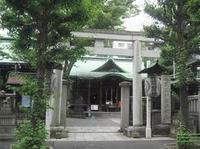 You can visit each local shrine, or visit a shrine that is concerned about going back and forth for shopping. You can visit each local shrine, or visit a shrine that is concerned about going back and forth for shopping.
There are also routes in Chuo-ku where you can enjoy cultural and history and walking at the same time, such as "Nihonbashi Seven Lucky Gods" and "Ginza Hachisha Tour", so it is recommended that you visit as a stroll on holidays during the year-end and New Year holidays.
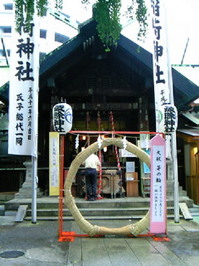 Then, if you come to Tsukiji Market to buy ingredients for New Year's cuisine, please drop in at [Namishi Inari Shrine]. From mid-month to January 10, "Chinowa" is installed in front of main hall. You can go through this ring to remove trouble. Why don't you make a New Year's pledge? Then, if you come to Tsukiji Market to buy ingredients for New Year's cuisine, please drop in at [Namishi Inari Shrine]. From mid-month to January 10, "Chinowa" is installed in front of main hall. You can go through this ring to remove trouble. Why don't you make a New Year's pledge?
Even if you don't usually go to shrines, many people go to "new year worshipping" on New Year's Day. I asked a certain person, but it seems that it is not good to ask God for various things realistically. Rather, it seems meaningful to look back on his vows, reflections, and gratitude in front of God. Depending on that attitude, there is also God's protection. So it would be quite nice to look back on the year quietly in the precincts that are not so crowded at the end of the year.
I hope that next year will be a better year for you.
Thank you very much for your continued support this year.
[Silver]
December 22, 2014 09:00
At the end of the year, you can hear Santa Clause is coming to town.
Tsukiji Foreign Settlement was established in the current Akashicho area in 1868 (1868).
Since then, the settlement has been built with Western architecture schools , hospitals , hospitals , churches, and residence , churches, and residence s, and this area has become a window for Western culture. s, and this area has become a window for Western culture.
With the amendment of the treaty in 1899 (1899), the settlement of Tsukiji was abolished as well as other settlements. There is an explanatory version describing the origin of the site. ・・ ・ I think this is an explanatory version in front of the St. Luke's Tower.
The above explanation was a part of the Chuo-ku Tourism Certification.
In Akashicho, there are many birthplaces of mission schools.
Today, I heard the Melo Day of Jingle Bell, so I visited the Catholic Tsukiji Church Cathedral. of Jingle Bell, so I visited the Catholic Tsukiji Church Cathedral.
The Catholic Tsukiji Church Cathedral was built in 1874 (1874) as the second Christian church following Nagasaki and Yokohama in the Tsukiji Foreign Settlement.
The cathedral was built in 1878, but it was burned down in the Great Kanto Earthquake, so this building was built in 1927 (1927) after the Taisho Earthquake.
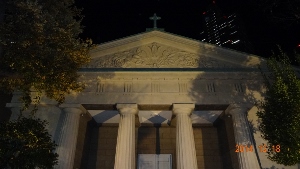
According to the introduction board of the Tokyo Metropolitan Cultural Properties, the Tokyo Metropolitan Government
This building was designed by Father Jirodias, Onjiro Ishikawa, a evangelist, and is a beautiful building in Yumi.
There are six Doria-style pillars, and the gable wall in front of the roof has sculptures  of roses and tulips. of roses and tulips.
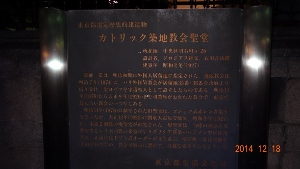
In addition, according to explanation version of Chuo-ku Board of Education, we understand the details again.
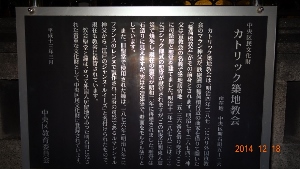
In the past, when I saw the interior of the church, there was a copper bell cast in France, which was designated as the central ward Tangible Cultural Property.
How about visiting a peaceful church during the busy hours of the end of the year?
Wishing you a Merry Christmas and a Happy New Year. 
Feliz Natal e prospero ano novo. Happy New Year.
[Mr.Chuo-ku]
December 19, 2014 15:00
Founded in 1899, Yoshinoya's founding store (the first store) is located in the central wholesale market food in Tsukiji, Chuo-ku, with approximately 1,800 stores in Japan and overseas as the largest beef bowl chain.
※↓Click to enlarge each photo and image.
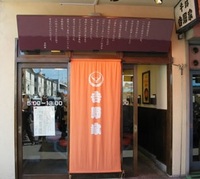
①Company name is Yoshinoya Co., Ltd. (English name: YOSHINOYA CO., LTD.)
※The character of Yoshi is correctly "soil" and "mouth".
②Founded in Nihonbashi Fish Bank, Chuo-ku

③The menu at the first store is only beef bowl, beef plate, and familiar side dishes such as miso soup and egg.

(1 company name, 2 photos, and 3 menu are excerpted from the official website.)
The following is a story I've heard.
The meat used at this first store is Japanese beef. Onion is also fresh and soft, and here Tsukiji is a place where "fresh ingredients" and "food professionals" gather, and you are also particular about beef bowls.
Also, at the time of ordering, options such as `` Negidaku '' and `` Tsuyudaku '' are all Yoshinoya, but at the first store, the degree varies depending on how many times you say `` dakudakudaku '' such as `` Negidakudaku '' and `` Tsuyudakudaku '' It seems to be. In addition, there are also "tsumeshiro (cold rice)" and "torodaku (a lot of meat fat)". The Tsukiji store, which was founded on the fish shore as Yoshinoya, seems to have special attention and has changed its stance from other stores.
Address: 5-2-1 Tsukiji, Chuo-ku, Tokyo Central Wholesale Market Food C
Business hours From 5:00 to 13:00
Regular holidays: In accordance with the Tsukiji Market
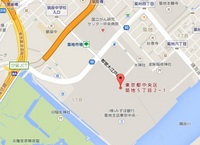
Official Homepage
Yoshinoya No. 1 store:
http://www.yoshinoya.com/shop/tsukiji/index.html
History of Yoshinoya:
http://www.yoshinoya.com/company/history.html
[Sumida Fireworks]
December 10, 2014 09:00
This year was just 50 years since the Tokyo Olympics in 1964.
To commemorate that, events were held in various places, and special features were set up on TV programs, and something became a hot topic.
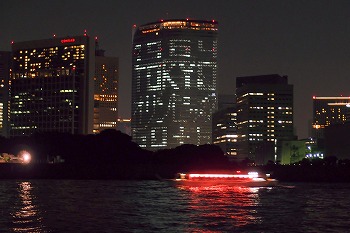 (Photo: October 11, 2014 Kachidoki, Chuo-ku, scenery of Shiodome on the opposite shore of Sumida River, 1964TOKYO Olympics 50th) (Photo: October 11, 2014 Kachidoki, Chuo-ku, scenery of Shiodome on the opposite shore of Sumida River, 1964TOKYO Olympics 50th)
In preparation for the Olympics, various transportation infrastructures such as Shinkansen, expressways, and monorails were being prepared.
In Chuo-ku, I think of the Metropolitan Expressway, which was built over Nihonbashi.
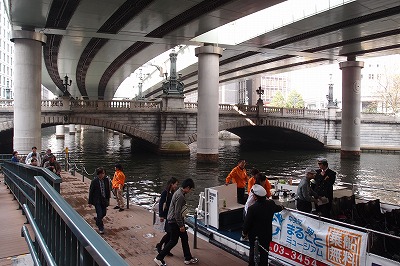 (Photo: Nihonbashi free cruise at the Marugoto Museum in Chuo-ku on November 2, 2014) (Photo: Nihonbashi free cruise at the Marugoto Museum in Chuo-ku on November 2, 2014)
Another other is the Tsukuda-ohashi Bridge, which was first bridged over the Sumida River after the war.
It wasn't very much taken up, though
Since it is opened in 1964, the same as the Olympics, this is also the 50th anniversary this year.
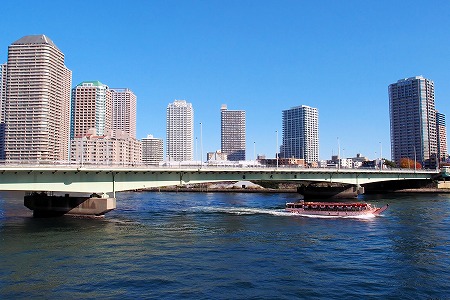 This time, I took up this bridge. This time, I took up this bridge.
This bridge connects Tsukuda Island and Tsukishima with Akashicho and central Tokyo, but it cannot be said that it has a very big feature in its appearance and shape.
However, in order to meet the Olympics, the bridge work was carried out at a rapid pace by combining the technologies of the time.
It can be said to be a symbol of Japan's high economic growth period when this bridge was built.
Before this bridge was built, the ship of Tsukuda's ferry, which was located at the same position as the bridge, was a citizen's foot.
It seems that this ferry was abolished at the same time as the opening of the bridge (August 27, 1964).
You can search for old images on the website of the Chuo City Library, but when I searched, I was able to find valuable photos from that time.
Link ⇒ Open Tsukuda-ohashi Bridge
This ferry on Tsukuda Island dates back to the rowing ferry in the early Edo period that connects Tsukuda Island and the city of Edo.
It was an event that ended with a history of 320 years.
Link ⇒ Ferry on Tsukuda Island
Many new historys have been created by the Olympics.
On the other hand, there were many things that were lost?
I looked for the remnants of this ferry around Tsukuda-ohashi Bridge.
The first is the monument of Tsukuda Island ferry on both banks of the Sumida River where the ferry was located.
 There are various changes in the ferry itself, but this monument was built in 1927 when the fare of the ferry operated by Tokyo City at the time became free. There are various changes in the ferry itself, but this monument was built in 1927 when the fare of the ferry operated by Tokyo City at the time became free.
The other is the "Lighthouse of Ishikawajima and the scenery of Tsukuda handing over" carved in the ranma of the basin (Omizuya) in Tsukuda Island and Sumiyoshi-jinja Shirine.
 If you are purifying your hand in the basin when you visit Sumiyoshi-jinja Shirine, please take a look at the top. If you are purifying your hand in the basin when you visit Sumiyoshi-jinja Shirine, please take a look at the top.
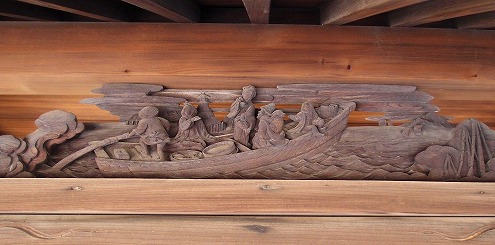 Each of the four sides of this building has sculptures related to different Tsukuda Island, one of which is "Ishikawajima Lighthouse and Tsukuda Passing Landscape". Each of the four sides of this building has sculptures related to different Tsukuda Island, one of which is "Ishikawajima Lighthouse and Tsukuda Passing Landscape".
It seems to have been carved in the Meiji era.
By the way, over the past 50 years, the environment and landscape around this bridge have changed, and the landscape from this bridge has changed every moment.
This Hashigami has an excellent sense of openness, so it has a good view and you can worship a very good landscape.
You can see the scenery of Chuo-ohashi Bridge and the Sky Tree in the upper reaches of the Sumida River.
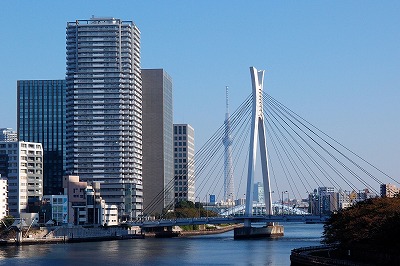 Of course, you can also see the streets of Tsukuda and the apartments in River City. Of course, you can also see the streets of Tsukuda and the apartments in River City.
And there are three arch bridges in the downstream area?
A new view has been added recently.
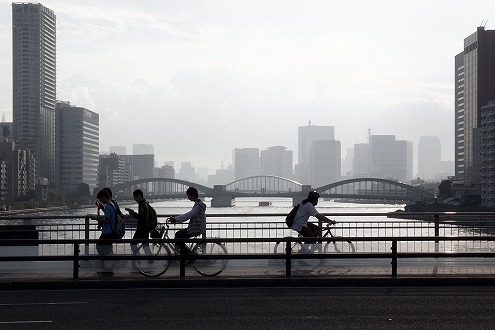 One arch of "Tsukiji Ohashi" formed at the lowermost stream of the Sumida River and two arches of "Kachidokibashi" in the foreground. One arch of "Tsukiji Ohashi" formed at the lowermost stream of the Sumida River and two arches of "Kachidokibashi" in the foreground.
There is a place on Tsukuda-ohashi Bridge that is similar in size and does not seem to overlap.
Did the people at the time of 1964 imagine the current landscape 50 years from now?
I can't imagine what the scenery will change in 50 years, but I hope that the good old scenes of Japan will remain.
|
Links
|



 ※2014/12/6 Shooting
※2014/12/6 Shooting
 ※Be careful of traffic because you can't see it unless you go on the road for half a step.
※Be careful of traffic because you can't see it unless you go on the road for half a step. ※2014/12/13 Shooting
※2014/12/13 Shooting










 (Photo: October 11, 2014 Kachidoki, Chuo-ku, scenery of Shiodome on the opposite shore of Sumida River, 1964TOKYO Olympics 50th)
(Photo: October 11, 2014 Kachidoki, Chuo-ku, scenery of Shiodome on the opposite shore of Sumida River, 1964TOKYO Olympics 50th) (Photo: Nihonbashi free cruise at the Marugoto Museum in Chuo-ku on November 2, 2014)
(Photo: Nihonbashi free cruise at the Marugoto Museum in Chuo-ku on November 2, 2014) This time, I took up this bridge.
This time, I took up this bridge. There are various changes in the ferry itself, but this monument was built in 1927 when the fare of the ferry operated by Tokyo City at the time became free.
There are various changes in the ferry itself, but this monument was built in 1927 when the fare of the ferry operated by Tokyo City at the time became free.
 Each of the four sides of this building has sculptures related to different Tsukuda Island, one of which is "Ishikawajima Lighthouse and Tsukuda Passing Landscape".
Each of the four sides of this building has sculptures related to different Tsukuda Island, one of which is "Ishikawajima Lighthouse and Tsukuda Passing Landscape". Of course, you can also see the streets of Tsukuda and the apartments in River City.
Of course, you can also see the streets of Tsukuda and the apartments in River City. One arch of "Tsukiji Ohashi" formed at the lowermost stream of the Sumida River and two arches of "Kachidokibashi" in the foreground.
One arch of "Tsukiji Ohashi" formed at the lowermost stream of the Sumida River and two arches of "Kachidokibashi" in the foreground.
